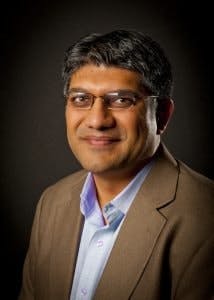Jigar Shah is best known as the founder of SunEdison, a company that helped propel solar on its meteoric growth path with “no money-down” solar financing.
Jigar Shah, Generate Capital
But now he’s putting his money and passion behind fuel cells and other clean resources to move the “resource revolution” forward and help the banking community feel more comfortable with these technologies.
His latest company, Generate Capital, provides the financing, operating expertise and connections needed to drive new technologies forward, including fuel cells, electric vehicles and anaerobic digesters, he says.
“We believe that the climate solutions that have been defined by the International Energy Agency and others need to be scaled up faster. While you see finance and operating solutions in solar and wind, it hasn’t translated well to other sectors,” he says. “It’s our job to finance infrastructure to make it affordable to the customer. It all comes down to getting the finance community comfortable with the technology.”
His company doesn’t favor one technology over another, but rather works with the developers who will do good work.
Leveraging relationships
And funding isn’t all that Shah’s company provides; he’s quick to take advantage of his large network of contacts — acquired through his work at SunEdison.
“We benefit developers with our money. But if all we are is money, we are just a commodity. We also provide sales, support and contacts,” says Shah.
For example, Shah helped Plug Power communicate to Walmart that the company was uneasy about the terms of a proposed contract Walmart offered Plug Power.
“Plug Power wasn’t comfortable with upsetting the customer. Since I know Walmart well — I was the first to get Walmart going on solar — I talked to them about the Plug Power contract,” he says.
Helping companies like Plug Power — which develops fuel cells — is all about making these technologies more successful in the long run. The companies do the work, Shah likes to say; Generate Capital sells them to the banking community.
Update: In March of 2021, Jigar Shah was selected by the Biden administration to run the Department of Energy’s (DOE) loan program. He continues to advocate for microgrids, as seen in this story: This is why microgrids are becoming popular: Jigar Shah.
“We are in a service business, we are serving entrepreneurs who are doing the work,” says Shah. “They sell to the customer, maintain the assets and do the work. We are in the business of evaluating the work they’ve done to make sure it’s a good risk. We sell their stories to other financiers to make projects more successful over time.”
Generate Capital has made more than $1 billion in financing commitments since it was launched four years ago, says Shah.
Most recently, the company signed a contract to provide financing for FuelCell Energy. The contract will finance the construction, installation and commissioning of the company’s ongoing and backlog of projects. Under the agreement, Generate Capital will provide between $100 million and $300 million, if certain performance criteria are met, according to a FuelCell press release.
FuelCell expects to use the financing to fund the construction of utility-scale projects, including three that total 39.8 MW with PSEG Long Island. Two projects, totaling 22.2 MW, are in Connecticut, and were award winners in a state Department of Energy and Environmental Protection request for proposals.
“FuelCell has been successful enough to meet our criteria,” says Shah.
Why fuel cells
Fuel cells are gaining ground because they’re an important non-wires alternative to grid upgrades, he says.
“Fuel cells are much cheaper than upgrading a substation,” he says. “It may cost $100 million to upgrade a substation and $20 million to put in fuel cells. Non-wires alternatives are becoming more commonplace.”
That’s true in part because public utility commissions (PUCs) across the country see that upgrading substations has caused rates to increase as much as three-fold over the last 10 years.
“There’s a desperate hunt on the part of PUCs to manage the grid and get it to more efficient utilization,” says Shah.
However, in spite of the advantages of fuel cells, right now it’s easier to finance a natural gas engine than a fuel cell. Shah wants to change that.
First of all, fuel cells are more efficient than natural gas, he says.
“A lot of microgrids feature natural gas engines as opposed to fuel cells, which have a better environmental profile. They also have a higher total system efficiency.”
Fuel cells versus natural gas generators
As an example, Shah compares a 1.4-MW fuel cell unit to a 1.4-MW natural gas engine. Natural gas has an efficiency of about 40 percent. Even in a combined heat and power (CHP) system, the natural-gas based system will only reach 70 percent efficiency, he says.
A fuel cell, on the other hand, operates at about 50 percent efficiency and can be as efficient as 90 percent if it is part of a CHP system. And fuel cells are easier to maintain, he says.
What’s more, they can make more sense than storage as non-wires alternatives.
Consider a non-wires alternative program that uses demand response. It can be expensive finding customers who are willing to change how they use energy to reduce peak demand. Fuel cells can be less expensive, he says.
Another advantage to fuel cells: It’s easier to get them permitted in areas like California and New York, where natural gas plants are often opposed for environmental reasons. “In these areas, getting fuel-cell permits is easier because of the fact that it’s an emerging technology and clean,” says Shah.
Shah’s efforts to drive these new technologies forward were sparked after his successes at SunEdison helping move solar into the mainstream, he says.
“When I left the company, my passion was taking all this knowledge about being an insider into convincing the banking industry to trust the solar asset class. I want to take that knowledge and apply it to other technologies,” he says.
Track news about project finance for microgrids, fuel cells and related clean energy tech. Subscribe to the free Microgrid Knowledge newsletter.








